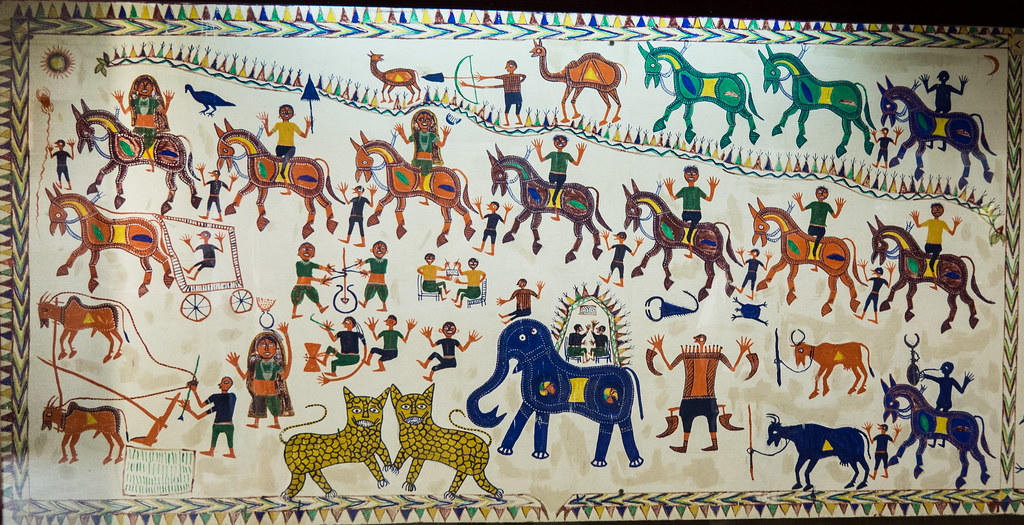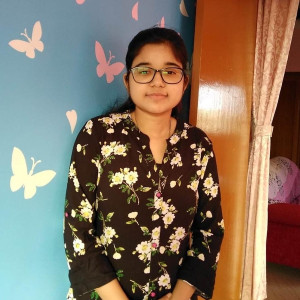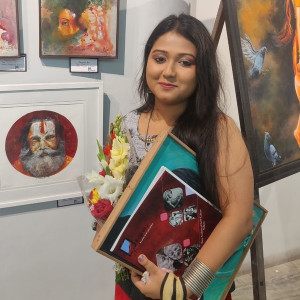Gujarati pithora paintings are a visual feast with vivid hues and detailed patterns. These folk paintings, which are frequently produced during festivals and celebrations, tell tales from mythology, folklore, and everyday life. The artwork usually shows horses, gods, and the natural world, demonstrating the artist's ability to combine originality and tradition.
The Rathwa, Bhil, Nayak, and Tadi tribes practice the style of Pithora painting of Gujarat, as well as other areas of Rajasthan and Madhya Pradesh. These paintings have their roots in cave drawings found on a nearby mountaintop close to Koraj-i-dungar, which date back many thousand years. The social, cultural, and mythical lives and beliefs of the tribe are shown in these paintings.
The main wall of the house, which separates the kitchen from the verandah, is painted with Pithora murals. Pithoro, the primary deity of the tribe and the god of food grains regards this area of the house as sacred. The Warli and Saora tribes paint part of their designs on the same wall. Additionally, if the kids are sick or if the kids or animals are stubborn, the Pithora paintings are created.
Pithora paintings are mostly creation legends and are rarely constructed for ornamental or decorative purposes. Additionally, they paint a variety of scenes, including those involving other deities, spirits, and ancestors, on the verandah's three walls. The representation of animals engaging in sexual activity alongside man is very fascinating.
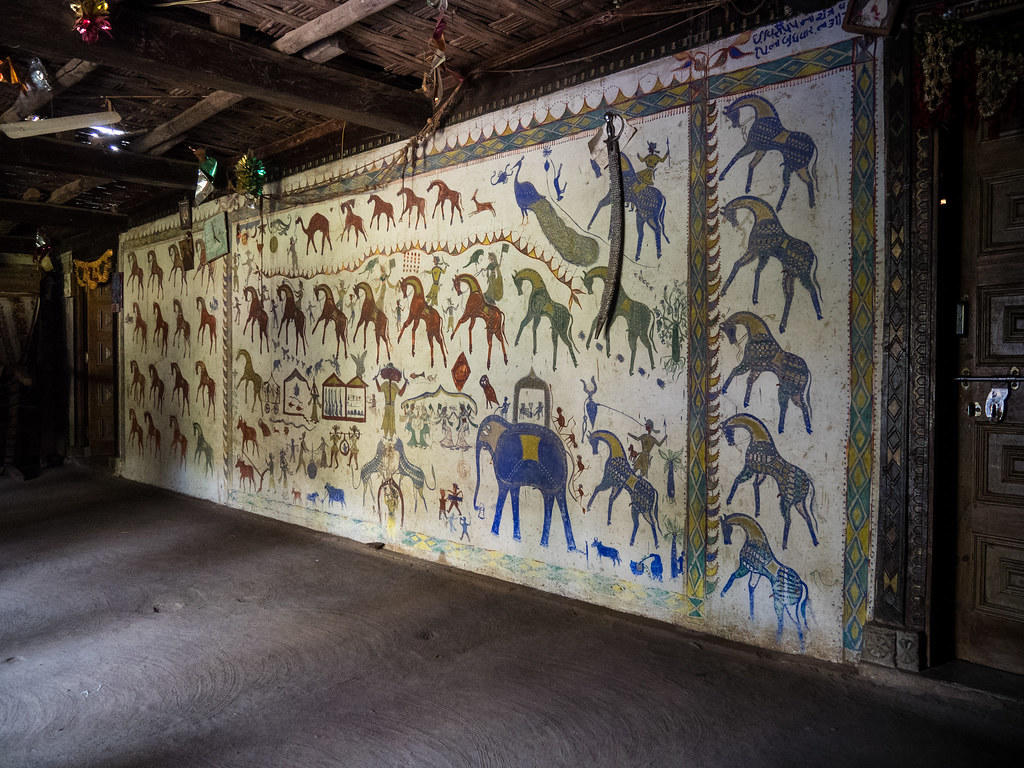

Origin of Pithora Chitrakala
The Pithora painting style, thought to be a divine process and strongly associated with divinity, dates back thousands of years and is believed to have originated from prehistoric cave paintings. The holy Pithora art, created by an artist who is able to channel the spiritual component of nature, is practiced by the Rathwa, Bhils, and Bhilala tribes, who are part of the broader Bhil group. The Pithora artists don't start painting until after the Diwali celebration has passed and they have had a successful first harvest.
Discover the vibrant world of Madhubani paintings.
Pithora, the chief deity of the Bhils, is portrayed in these ritualistic and hallowed paintings, and a pageant is invariably shown doing his acts. Pithora paintings are also said to infuse the house with prosperity and serenity. Placing the painting at the home's threshold invites the painting's auspiciousness within.
The parts each member of the community plays in the making of a Pithora painting divide it in half. The priest who sings and chants while the painting is being created is known as the badwa; the artists are called lakara; and the people who monitor the painting's progress are called jhokara. After the artwork is finished, it is checked by the badwa for errors and incomplete work, which is then fixed. When a member of the family suffers a severe illness or bad luck, they pray to their god Pithora. When they receive healing, they paint a picture of Pithora with the help of their priest. A painting's completion is marked with special festivities.
Because these tribes escorted traders as they traded from the coast to Gujarat's interior and beyond to Madhya Pradesh, it is thought to be an ancient technique of mapping. It is also believed that the Bhils created the painting elements as a code so they could keep the mapping skill to themselves.
These paintings, which are conceptual representations of the world the tribes inhabit, are created by the artist based on how they observe their surroundings. As a result, in addition to the classic aspects, you might see contemporary accents in the paintings that depict nature. The older males in the tribe teach the adult, married men alone how to paint by hand. All paintings are done by hand. Any work completed outside of the guidelines will not be accepted by the tribe.
Pithora Painting UPSC Notes
The horse, which is used to represent the gods, goddesses, and ancestors, is one of the most frequently seen figures in Pithora wall murals. The seven hills encircling their area are represented by the seven horses that are shown in the paintings. Pithorani and Pithoro's main characters are made of white. The rain god Walan and Ramdev are among the other gods shown.
The kumaris, or single girls, prepare the walls for Pithora wall murals over the course of seven days by mixing clay and cow dung. However, men work in groups of seven or eight to complete the paintings. The white clay, pandurya, is what gives the background its distinctive white color. It is revered by the Rathwa tribe and is thought to cleanse the painting's background. The Pithora wall paintings feature the colors orange, green, blue, yellow, and red.
Pithora Motifs
The Pithora paintings have a multitude of motifs, each with a distinct portrayal. The whole picture is created inside a hallowed space. The plane is divided into two sections by a wavy line. The world of the gods is shown in the section above. Ganesha is the first figure to be painted. In the lower right corner, he is depicted as a horse. This section also features images of other deities.
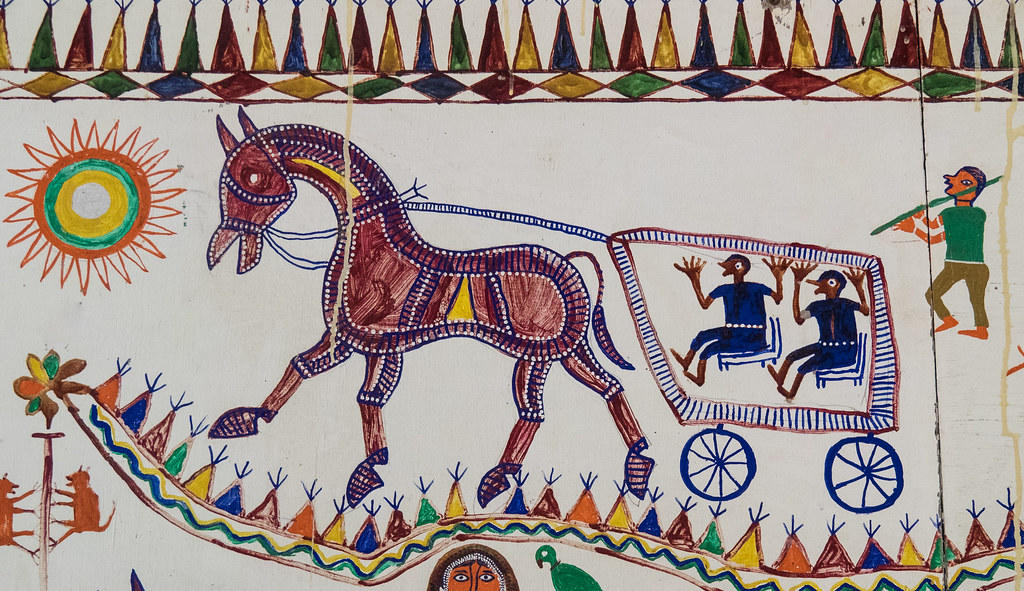
The Pithoro marriage procession is shown below the wavy line. It is depicted as a royal wedding procession and is the most significant feature of the painting. Usually, the wedding mandapa is a triangle that is pictured directly over the bridal procession. The picture has been influenced by aspects of royal life, as evidenced by the use of chariots, horses, elephants, costumes, and decorations.
Take a deep dive into the living tradition that is Warli art.
The creation tales are portrayed in the painting's lower half. The earth, mythological farmer, cow and bull, cowherd, kings, the goddess of destiny, different forest creatures, and lesser deities are all visualized in this way. In addition, there are depictions of cosmic and supernatural figures like the sun, moon, field horses, village gods, and khatri, the ancestor's horses. In Pithora paintings, Raja Bhoja and elephants are shown in the last row.
Tipna are the orange dots located in the middle of the Pithora paintings. These are created using the fingers after the painting is finished. In Pithora, no two paintings are alike. To indicate his creative rights over each painting, the artist leaves a unique mark on each one.
Gods in Pithora Paintings
- The first figure to be depicted in any Pithora painting is Ganesh, also known as Baba Ganeh. He is regarded as the father figure and possesses an elephant trunk.
- The god of rain and animal protection, Indra, also known as Baba Ind.
- The main goddess in the Pithora paintings is Pithora deva. He is the representation of all the universe's creations.
- The animals worship Raja Bhoja in hopes of receiving bountiful agricultural and cattle outputs.
- The originators of farming are revered as Abho Kunbhi and Mathari. They revere their daughter Rani Pithoro amid the erratic monsoons.
- The tribes also revere rani Kajal, another female deity. She is revered by the tribe as their kuldevi and mother.
Customs Surrounding Pithora Paintings
Without the chanting and singing, the paintings aren't complete. The badwa, or head priest, is in charge of overseeing the panghu vidhi and makai ni vidhi rituals connected to the Pithora painting's installation.
According to a tribal tradition, a long time ago, during a period of drought on our planet, a devotee pledged to satisfy Pithora deva, and shortly after, it began to rain. He subsequently arranged to have Pithora deva painted on his house's walls. The painting was started after wishes were granted or difficulties were overcome.
Akho pithoro (full Pithora) and Ardho pithoro (half Pithora) are the two categories of Pithora paintings. It is contingent upon the vows made and the devotee's financial situation. Five to nine horses are shown in ardho pithoro. All of them, barring Lord Ganesh, are without riders. Eighteen horses and their riders are painted in Akho Pithoro.
Pithora Paintings of India: Changing with the Times
For those who practice it, Pithora is more than just a kind of art; it's a way of life that allows them to represent their society, culture, and history. It features many motifs, each with their own significance. Every deity in the picture has a distinct meaning and is shown with certain goals and challenges in mind. Pithora's paintings of nature symbolize its significance and interconnectedness in their day-to-day existence.
There are only seven or eight true Pithora artists working at the moment, according to reports. For most Bhils nowadays, art is a secondary career. The time for introspection and concentration that is required for the divine process to take root in an artist is taken away by adjusting to the fast-paced nature of the modern world. A lot of people have given up painting as a result of bad retail rates, migration, economic troubles, and loss of desire.
Religion permeates all types of art in India, including the famous Pattachitra art of Odisha and West Bengal.
Pithora Art: FAQs
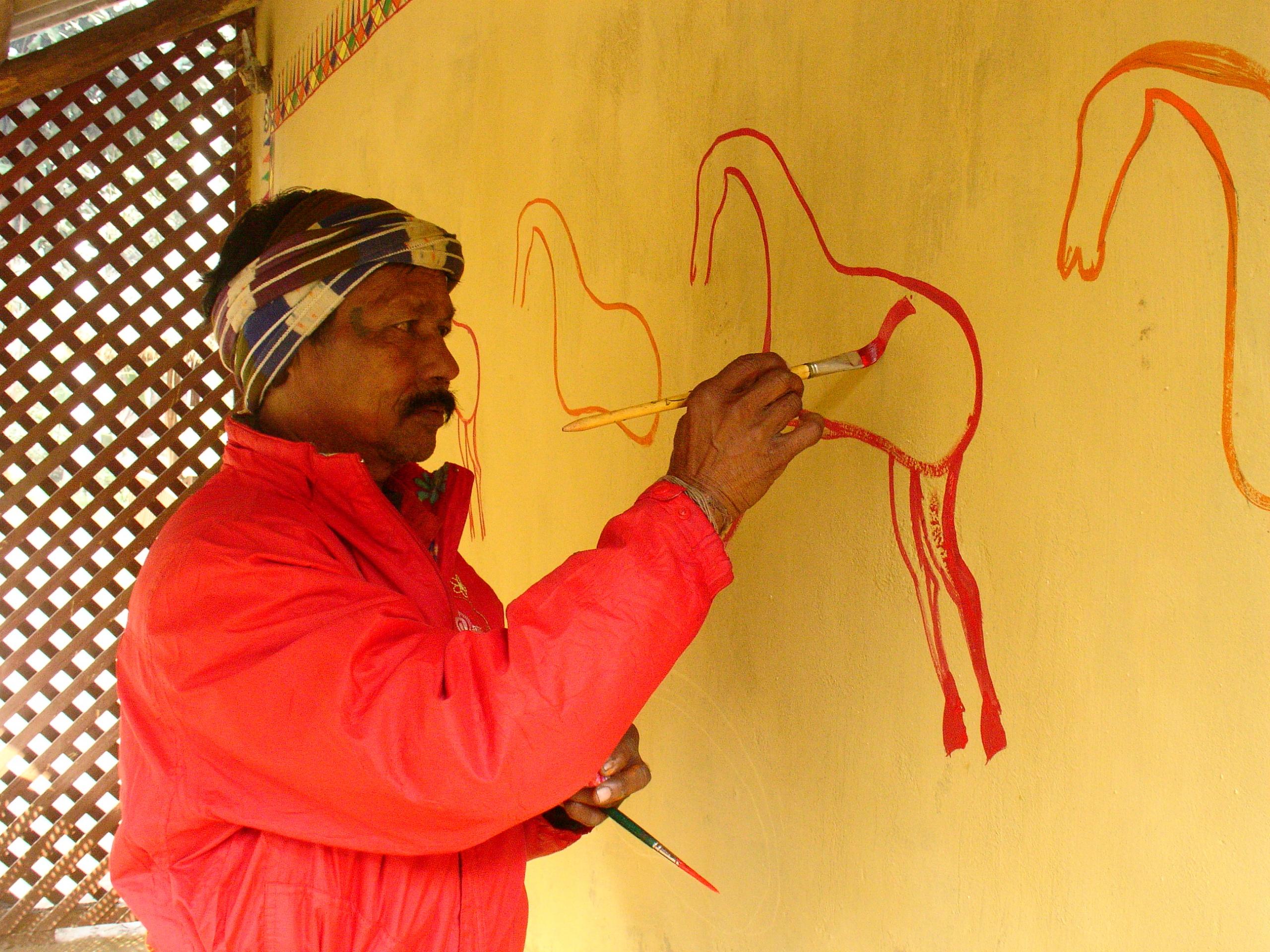
What is Pithora art?
Pithora is a type of wall painting, distinguished by its seven horses. These seven horses are thought to symbolize the seven hills that surround the border regions between Gujarat and Madhya Pradesh. The tribe's god, Pithora (Pithora Baba), is the inspiration of the moniker "Pithora painting."
From its western frontiers to its east, India is home to some of the most ancient folk art forms, including the Buddhist Thangka paintings.
Which state do Pithora paintings belong to?
The Rathwa, Bhil, Nayak, and Tadi tribes from Gujarat, along with some regions of Rajasthan and Madhya Pradesh, are the artists behind the Pithora paintings.

